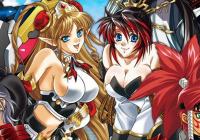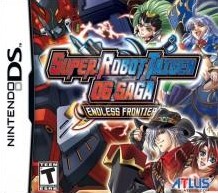Super Robot Taisen OG Saga: Endless Frontier (Nintendo DS) Review
By Rudy Lavaux  15.04.2016
15.04.2016

It's hard to keep track of franchises like Castlevania, which counts over 20 titles, and a few spin-offs and partial remakes along the way. Super Robot Taisen is quite similar. Originally a Tactical-RPG series that started back in 1991 on the Game Boy, starring big giant robots from some of the most popular anime of the '70-80s, in a massive cross-over of universes. That series saw a few numbered entries, and then more spin-offs than main titles, subtitled all things Alpha, Alpha Gaiden, A, F, R, D, J, W… and so on. Those are only a very few, and it's a complete mess already. Among them, only a small sub-series of two games, relevant to the reviewed one, saw release outside of Japan. Super Robot Taisen: Original Generation and its sequel, were released in North America for the Game Boy Advance, and it's easy to imagine why. This featured original robots/characters, not tied to any existing franchise, therefore no licensing problems would get in the way of a US release. In the midst of this huge mess (for people outside of Japan), a handful of non-Tactical RPG games were released, leading to Super Robot Taisen OG Saga: Endless Frontier for the Nintendo DS in 2008 in Japan, and the year after in N. America, and, once again it does feature only original characters.
A traditional turn-based RPG at core, it's by far the most accessible in the series, while still retaining much of its atmosphere about space wars and futuristic technology. The plot revolves around the character of Haken Browning; a womaniser bounty hunter who takes on retrieval missions for a living. He is accompanied by a female android called Aschen Brödel, who has the particularity to be overly serious and to speak in a solemn voice at all times, but to become a hyperactive, and overly cheerful girl shouting in a high-pitched voice when she activates her "Dust-to-dust" mode, which unleashes her full physical strength. This DTD, makes for many hilarious remarks and moments throughout the whole story too. However, when she activates that mode in battle to perform what is known as an overdrive attack, the part of her armour covering her chest bursts open, revealing more of her boobs as she performs her destructively powerful attack.
This last particularity is undeniably part of what caught peoples' attention so much upon being announced for coming to the west. Indeed, this likes to tease players by showing more female skin than would otherwise be expected. It was still rated "T for Teen" by the ESRB in North America, though. While this will undeniably be a huge part of the appeal for a certain section of the audience, it is also nowhere near as openly perverted a the Senran Kagura series. Here it is used for comical effect more than anything else. Early on in the story, Haken and Aschen meet another young woman with oversized breasts barely covered by her clothes, named Kaguya Nanbu, who will be the subject of many mammary puns throughout the game, being referenced to as a cow by certain characters, and, therefore, when a Minotaur pops up in the story, he wants her for wife.
Kaguya turns out to be the subject of a retrieval mission that the two heroes had actually not yet accepted. As she is taken back to her home world for the reward on her head, all the worlds interconnected together and forming the Endless Frontier, to start being infested by a certain type of seemingly indestructible crystal. From there on, the plot revolves around investigating what's causing these crystals to spread and how to stop them, seeing all the damage that they're causing. The several planets on which the story takes place are all interconnected by dimensional gates, as each planet exists within its own universe. The party will move from one to the other via these gates, to move the story forward. It appears very linear, as the party is pretty much always pushed towards their next destination by the unfolding of events, and as it does so, more characters join the party.

Nothing prevents players from going back to previously visited locations and if a particular section will lock the party in a specific location that might forbid going back, the game makes a point of saying so, which is a welcome move indeed. It is sad to say, however, that there are practically no optional locations whatsoever, and pretty much no side-quests at all, with every location in the game getting visited from just experiencing the story. They can most often be completed on first visit, and there's rarely reason to go back, save for one or two chests that require a certain object to be reached. Incentive for exploration is thus severely limited.
In terms of presentation, the field graphics are pretty poor by DS standards. In fact, they would look a bit sub-par even on the Game Boy Advance for that matter. Characters can only move in four directions, old-school style, and other than a handful of 3D objects in key locations, it could easily pass for a SNES game at best, which is quite unfortunate. A quick look at the credits at the end of the game, or in manual itself, shows indeed that much of the staff, over half of it in fact, was involved only in the battles, while much of the rest was assigned to the sound division, leaving the rest (counted on one hand) to take care of everything pertaining to maps.
So the battles have got to be pretty good, right? Indeed they are. They're the main point of focus, undeniably; fully-voiced, highly detailed, and very dynamic. Any initial suspicions are confirmed that much of the budget and staff were invested into making those as badass as they could be. In fact, characters are rarely ever voiced over outside of battles, but they won't shut up while in. Additionally, when outside of battles this could look like a late SNES game port - in fact, similarities could be drawn with the look and feel of the first Star Ocean, which had the luxury of looking closer to the PS2 game when in-battles, or Namco x Capcom, also developed by Monolith Soft. Comparisons to the latter are, indeed, not a coincidence, since the battle system is very much inspired from it. Characters take turns in attacking their foes, picking a target and starting chaining commands via timed button inputs. Normal attacks are called skills, and several can be performed on each turn, depending on characters' consumption of Command Power (COM).

Each character can only chain two different types of skills at the beginning, but more unlock as they level-up. Some COM can be spared by cancelling a chain of attacks, though. Skills come in different levels of power, and have different effects. Moreover, the player is free to use spells (known as Spirits) as many times as they please, before a character has even attacked, which makes it easy to heal, and, thankfully so, considering how hard certain battles can get, and how tough certain enemies - especially bosses - can hit. Spirits consume COM points too, but those can be restored before attacking using restorative items. The focal point of battles however will likely be the tension gauge. Each hit on the enemy, as well as hits received, build up a tension gauge which once filled will let a character of the player's choosing perform its aforementioned unique overdrive attack.
A large percentage can be obtained when skills are chained correctly, by cancelling one currently being performed, and skipping to the next in the set order of skills chosen outside of battle. It's up to the player, however, to find out by trial and error at which point of the skill animation to cancel it, in order to earn a percentage bonus, to maximise both the damage a move can deal, while still netting the tension percentage bonus. Battles are extremely dynamic, since, once a character's turn ends, if the next turn belongs to another playable character, he/she can jump in before the previous one is done, and take its place in continuing to chain in the same combo! More than that, later in the game, characters left outside the active party can even become assist characters and add to the combo. Finally, certain mechs will join as well, but as assist-only characters.
Note that, if the combo isn't performed well enough in making the enemy fly into the air, and without ever touching the ground, this will leave windows open for the enemy to make a "Forced Evasion," which will make all subsequent hits in the currently performed skill hit their target, and, thus, put an end to the overall chain of actions, forcing the current character's turn to end, therefore, it's important to time button presses right. It's a very complex affair on a purely technical level, definitely not easy to master, but, thankfully, a training mode exists, and all the explanations given in the initial tutorial, which may seem a bit vague and obscure at first, can always be re-read as all tutorials seen can be read again from a dedicated menu.

Moreover, the training mode enables trying out newly obtained skills at leisure, looking for cancel bonuses, and so on, to one's heart's content, so it's not at all a question of dying multiples times until everything is understood and mastered. It's well thought-out through and through. Furthermore, battles are kept exciting by exquisite pixel-art sprite design, that ranks among the finest seen on the system, or on any system period, accompanied by gigantic, fully animated character portraits that can take up the whole screen, and that pop up during big actions to give the whole thing an insanely great look. These even have the luxury to look better than those in Namco x Capcom, although the character roster is a bit small, and they're also in a much lower resolution; but this doesn't show too much on the tiny screen of the original DS.
It's one of the best battle systems seen on the DS, or in any RPG pure and simple. There is only one downside to it, though. Boss battles can be extremely long, even when playing good, and, as was mentioned before, they can be tough indeed. Certain enemies, humanoids in particular, and pretty much every boss, will jump at any opportunity to net a forced evasion. Dying will most likely not be an uncommon occurrence, playing this DS title. Of course, the battles are definitely where most of the hard work by the development team was invested, and, while the rest of the game is certainly not bad, it is sad that the whole package doesn't show the exact same level of quality. The music is absolutely awesome, borrowing a bit from Xenosaga and Namco x Capcom in places by remixing certain tracks from those games, and, for better or worse, the Japanese voices are kept intact, with no English option proposed, meaning that all the character screams and shouts in battle, while very cool sounding indeed, will remain incomprehensible to people who don't understand the language.
Enjoyment of this here will naturally be increased for those who will get the references to other games in which Monolith Soft was involved. Reiji Arisu and Xiaomu, the inseparable duo of protagonists from Japan-only Namco x Capcom, are part of the main cast of playable characters, though western players are probably more familiar with the duo for their appearance in Project X Zone. Their associated antagonist, the overly sexy Saya, also makes an appearance as a villain. KOS-MOS is also part of the main cast of playable characters, an android from the Xenosaga trilogy, who also appeared is both Project X Zone and Namco x Capcom, and who also was a battle magnus is Baten Kaitos: Eternal Wings and the Lost Ocean, and, finally, her associated antagonist, T-elos, also plays a somewhat major role in this story.

Cubed3 Rating
Very Good - Bronze Award

Showing insanely high production values in its battles, but more middle-of-the-road levels of quality elsewhere, Super Robot Taisen OG Saga: Endless Frontier is high on eye-candy - especially for people who love looking at female chests, but not exclusively. Sadly, it is too linear, highly challenging in places, but, otherwise, not extremely long, clocking at about 35 hours for absolute completion. It lacks optional things to see and do, which would tie the, otherwise, interesting, universes together, but even without those, it remains a good product overall. The exciting battles show gorgeous visuals and great sound, and the interesting story and witty, humorous dialogue, will keep players pushing forward to see what will happen next. Atlus made the right decision in bringing it over to North America, so that more people could enjoy it, and it's just a shame that its sequel, Super Robot Taisen OG Saga: Endless Frontier EXCEED, remained exclusive to Japan, maybe because it pushed things even further in terms of content. If anything, there's potential here for a re-visit on the 3DS, with stereoscopic visuals to make certain visual aspects of the game… stand out more. We will leave it to readers to find out which elements those would be.

![]() 7/10
7/10
![]() 0
(0 Votes)
0
(0 Votes)
 None
None  Out now
Out now  Out now
Out now  None
None Comments
Comments are currently disabled

 Sign In
Sign In Game Details
Game Details Subscribe to this topic
Subscribe to this topic Features
Features





 Top
Top

